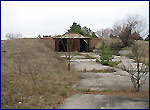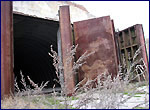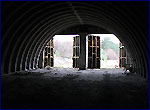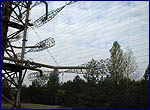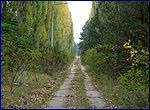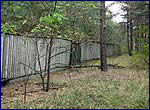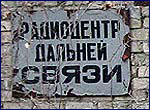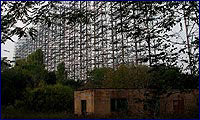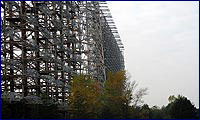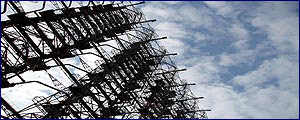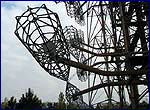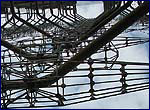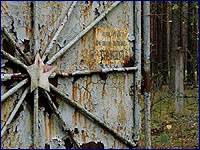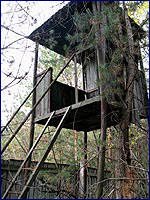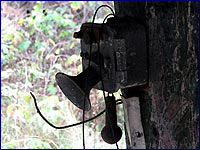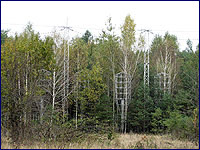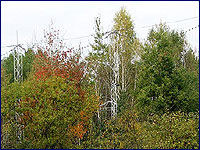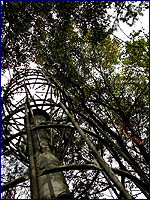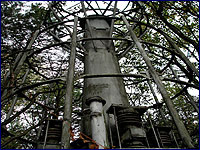| to main page |
Chernobyl-2. Strugatsky's Prophetic Fantasy.
From all I read in the Strugatsky, the greatest impression was left by "Tale of the Troika". In "The Inhabited Island", I recollected more recently having re-read the story - I was amazed at the genius of the writers. Surprisingly, as accurately and realistically in "The Inhabited Island" the authors managed to convey in words the situation and atmosphere of one of the most amazing places in the modern Chernobyl Exclusion Zone, one of the secret military installations of the former Soviet Union - the town of Chernobyl-2.
The modern landscape adjacent to the Chernobyl-2 territories is strikingly similar to descriptions in "The Inhabited Island." The same abandoned and overgrown young trees, vegetation and road communications. Plots of old pine forest are littered with fallen branches and dead trees. Among the forest were found the remains of abandoned equipment. Not far from the secret object is the once secret and now abandoned, air defense system. Now on the grounds of the missile complex can be found remnants of tractors and abandoned buildings. Especially intriguing is a rocket canopy - a large arched structure with massive steel gates
Chernobyl-2 - in the "shadow" of the small and quiet little Polessian town Chernobyl. As was typically accepted in the country won by socialism, all sensitive sites working as military targets were named for their neighboring cities. This was probably a simple way for the military to try to confuse enemy reconnaissance.
Twenty years ago it was quite a secret facility - a pearl of space exploration and the dream of the military, to monitor the movements of all kinds of elevated objects, not only above Europe, but also as a way "to see" the start-up of enemy missiles on the North American continent. With the help of powerful and ultramodern (at that time) radars, the military could, in the true sense of the word, look beyond the horizon. It is obvious that through such abilities this complex was named – Over-the-horizon radar station (OHRLS) or "Duga" (Radio center of telecommunications Chernobyl-2). In the Soviet Union, only three such radar installations were established - in Nikolaev, Komsomolsk-on-Amur and Chernobyl.
The unique ability of the radar lies in the designers innovative ideas to translate in the giant-sized structures and receiving antenna masts. It was difficult to talk about the exact geometric dimensions of OHRLS. The data in publicly available sources are contradictory and probably not accurate. Thus the large antenna mast height ranges from 135 to 150 meters and length from 300 to 500. The second radar was somewhat more modest - some 250 meters in length and up to 100 meters in height. With such amazing sizes, the object is visible from almost anyplace in the Chernobyl alienation zone. According to some sources, the cost of capital investments was seven billion Soviet rubles (though some sources report it at 600-700 rubles). As a comparison, it was twice as expensive as the Chernobyl nuclear power plant construction. Obviously, the construction of OHRLS near the nuclear power plant is due to the object's large energy needs. According to available information, OHRLS consumed approximately 10 megawatts.
It is important to note that OHRLS in Chernobyl-2 was intended to only receive signals. Another radar installation near the town of Lyubech in the Chernigov region, 60 km from Chernobyl-2 was designed for sending signals. The radar in Lyubech was smaller and lower than Chernobyl-2, it was 85 meters high. This radar installation has been destroyed.
Near the radar built in the Chernobyl area was established a garrison, where military personnel lived with their families. It should be noted that the garrison settlement included facilities such as a school, kindergarten, club, stadium, shops and even a hotel – “voentorga” (military shop). In the garrison was housed a separate military unit for space communications, No. 74939, commanded by Colonel Vladimir Musiets.
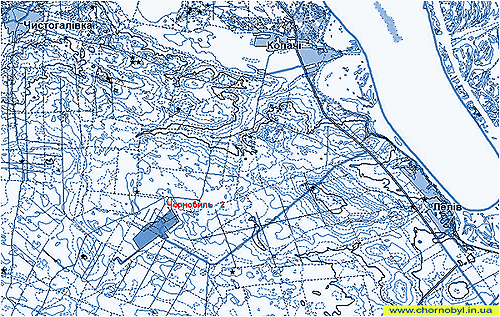 But the Chernobyl’s accident in 1986 changed the destiny not only for 100, 000 people evacuated from the zone of radioactive contamination, but also determined the sad fate of this top secret facility. Chenrobyl-2 has ceased to stand guard.
The tragedy of the situation with Chernobyl-2 was exacerbated by the fact that the Soviet air defense conferred upon OHRLS alert status in 1985, and in 1986 the system was fully upgraded and began to accept the state's acceptance. Prior to modernization, use of Duga was difficult because the working frequency range coincided with the frequency of aviation systems. Some sources claim that after the start of automation of the Chernobyl radar, western governments declared the system unacceptable because it impedes the safety of European civil aviation. The OHRLS developers rejected the accusations and said that the outrage of European governments is that the USSR covered European and NATO airspace with a "cap," but the countries could not prove it. After the modernization, the problem of OHRLS frequencies overlapping Civil Aviation frequencies was resolved.
The complete closure of Chernobyl-2 did not occur all at once - until 1987 it was inhabited. But over time, it became clear that it was impossible to maintain it under the conditions of the Chernobyl alienation zone. The main units of the OHRLS system were dismantled and taken away to Komsomolsk.
Today, it is indeed a real ghost town. Abandoned by the military and almost forgotten by people, the city is ravaged by radioactive contamination and dirty, cluttered forests. To the city, as in "The Inhabited Island" by Strugatsky, is an old, forgotten road from concrete slabs.
Today, travel to the city and OHRLS is difficult. The object regime is under the constant protection of one of the enterprises that works in the Chernobyl Zone.
Many can talk about the reigning devastation of Chernobyl-2 and the devastation of civilian and other buildings, as well as bringing about the depth of anguish when contemplating these places. It is possible to speak about nature's absorption of this technogenic monster, which consists of "tightening" of the concrete coating of roads and sidewalks by alluvial soil substrate and the decomposed remains of vegetation. Some brick structures are destroyed by trees which have grown on the structures' roofs and brick walls.
Yes, that's all there and all this is very impressive.
But these same processes are taking place throughout the Chernobyl alienation zone. Man abandoned settlements - buildings, roads and communications destroyed by the action of natural forces. Nature tends to balance and gradually get rid of the "footprints" of people.
After working in the exclusion zone for quite a long time, you get used to it and only from time to time you notice changes, a gradual transformation from an urban landscape to a natural landscape.
Chernobyl-2 is shocking. This is a unique monument to the intellectual power of military engineers of the Soviet Union. Chernobyl-2 eloquently and persuasively demonstrates a level of scientific, financial and raw potential of the military-industrial industry of the state. When viewing the towers and radar elements, involuntarily you reflect on the enormous resources spent on the creation of this unique complex. In fact, even today in 2008, the metal designs are sufficiently reliable and most importantly, they carry out their functional purpose - to hold up the enormous weight from the radar elements (vibrators) mounted on them. The cables bearing the masts and vibrators are without significant corrosive damage.
Intricately looking elevators in which service personnel were lifted to high locations. Now, elevators are on the ground with open doors, as if inviting...
Having thrown back your head looking upwards, you look at masts and somewhere there, in the sky above, clouds slowly pass by. It seems that time has stopped near the metal structures, and these structures, arguing in the course of time, cannot stand another ten years.
The unique facility, as it is easy to guess, demanded serious measures of protection. The perimeter configuration of a strict security zone can be seen now. On the external side, the solid perimeter fence guarding the site is topped with tight electric "barbs". At one time, the barbs were energized. Now on this fence hangs the laconic inscription, perhaps ever since 1986 - "Stop! Contaminated!", though signs of radiating danger are not visible.
From the inside, behind the fence, barricades of barbed wire were installed and patrol paths were established nearby. Observation towers were located at the corners of the security zone. Small, stocky structures of metal and wood look sad against the backdrop of the surrounding nature. Not far from the towers "fungi" (pickets) were arranged for the sentinels. Some are equipped with special intercoms. These devices are very rare, and surprisingly, have not been touched by looters - all the wires and even the tube is in place...
Very few people know, but except for the giant masts, the OHRLS was equipped with radar and a unique system of satellite communications. This facility is easily seen in aerial photographs (see aerial photograph). For example, the satellite, as presented in the Internet-source "Wikipedia" is listed as a "Satellite communications center." According to other indicated sources, the primary objective of the station Recurrent–Obliquely Sensing was an index objective for the larger radars of OHRLS.
However, the purpose of this element OHRLS was not for an ordinary person, it looked unusual. It is a platform in the form of a circle, with a diameter of 300 meters. On the perimeter, intricate elements (vibrators) covered by chrome or other corrosion-resistant metal. Gleaming in the sun, and partially hidden in the thickets of vegetation, these elements are somewhat mysterious.
In the middle of the "Circle" is a stocky, one-storied building. Possibly, it was an important element of Duga. The building, judging by the remnants of metal structures inside, was "filled to the ceiling" with electronics and other equipment. Today, the building is devastated and forgotten.
In conclusion, it would seem desirable to avoid trite words about admiration of the seen, unforgettable impressions you are left with after visiting, etc. This is clear, I hope, and without explanations. Leaving Chernobyl-2, I was not left with feelings of disappointment and bitterness. I absolutely do not understand the reasons for the isolation of the structure from the public. After all, today Chernobyl-2 is unique. It is unique in that it is the only object that survived up to our time. No other similar objects (in Nikolaev and Komsomolsk-on-Amur) no longer exist! Chernobyl-2 is the last surviving Soviet military monster that glances on the horizon. The superstate has disintegrated, leaving us with the memory of its military might. So why do we, instead of mere memory and simple human respect, betrayed this forgotten unique object and the people who created it!
Recently, there was a message in the media that Fyodor Bondarchuk tried to escape "The Inhabited Island" of Strugatsky. How unfortunate that filming for the movie did not involve
Brief historical information:
Designers and developers of OHRLS - E. Shtyren, V. Shamshin, Franz Kuzminsky, E. Shustov
Date and place of construction of the first OHRLS: ?in 1975 in the city Komsomolsk-on-Amur
The first pilot inclusion of OHRLS at Chernobyl-2: 1980
Design Institute: NIIDAR (Research Institute of Far Radio - http://www.niidar-rts.ru/)
P.S. Technical Information contained in this report was obtained from open and publicly available sources.
For more information about Chernobyl-2, you can visit "Chernobyl-2 - maps and photos"
|
|
| to main page |
|
You can share your thoughts, impressions and observations with the authors of the site via Email, or leave your feedback in the Guest Book.
Materials may only be used with prior permission from www.chornobyl.in.ua. The use of direct links is required. |



